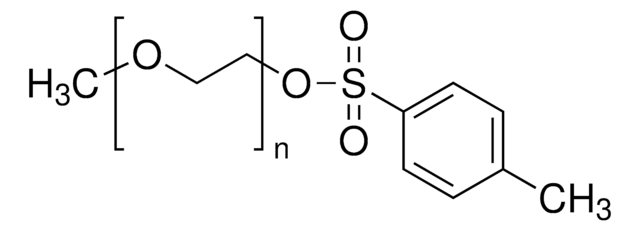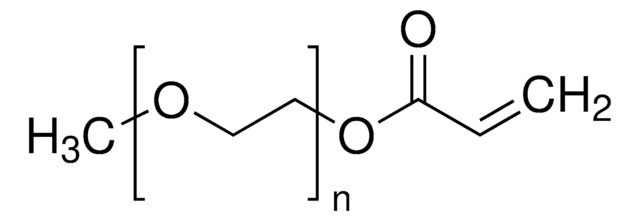202495
Poly(ethylene glycol) methyl ether
average MN 750, methoxy, hydroxyl
Sinónimos:
Polyethylene glycol monomethyl ether
About This Item
Productos recomendados
Nombre del producto
Poly(ethylene glycol) methyl ether, average Mn 750
vapor density
>1 (vs air)
Quality Level
vapor pressure
0.05 mmHg ( 20 °C)
form
paste
solid
mol wt
average Mn 750
refractive index
n20/D 1.459
viscosity
10.5 cSt(210 °F)(lit.)
transition temp
Tm 30 °C
density
1.094 g/mL at 25 °C
Ω-end
hydroxyl
α-end
methoxy
SMILES string
O(CCO)C
InChI
1S/C3H8O2/c1-5-3-2-4/h4H,2-3H2,1H3
InChI key
XNWFRZJHXBZDAG-UHFFFAOYSA-N
¿Está buscando productos similares? Visita Guía de comparación de productos
Categorías relacionadas
Application
- As a chain transfer agent to synthesize amphiphilic block copolymers by metal-free ring-opening oligomerization.
- As a precursor to prepare retinoic acid-polyethylene glycol nanoassembly as an efficient drug delivery system.
- To prepare diblock copolymer with polylactic acid, which can be applied in the field of tissue engineering and drug delivery.
Storage Class
10 - Combustible liquids
wgk_germany
WGK 1
flash_point_f
359.6 °F - closed cup
flash_point_c
182 °C - closed cup
ppe
Eyeshields, Gloves
Elija entre una de las versiones más recientes:
¿Ya tiene este producto?
Encuentre la documentación para los productos que ha comprado recientemente en la Biblioteca de documentos.
Los clientes también vieron
Artículos
Fouling Resistant Biomimetic Poly(Ethylene Glycol) Based Grafted Polymer Coatings
Progress in biotechnology fields such as tissue engineering and drug delivery is accompanied by an increasing demand for diverse functional biomaterials. One class of biomaterials that has been the subject of intense research interest is hydrogels, because they closely mimic the natural environment of cells, both chemically and physically and therefore can be used as support to grow cells. This article specifically discusses poly(ethylene glycol) (PEG) hydrogels, which are good for biological applications because they do not generally elicit an immune response. PEGs offer a readily available, easy to modify polymer for widespread use in hydrogel fabrication, including 2D and 3D scaffold for tissue culture. The degradable linkages also enable a variety of applications for release of therapeutic agents.
Devising biomaterial scaffolds that are capable of recapitulating critical aspects of the complex extracellular nature of living tissues in a threedimensional (3D) fashion is a challenging requirement in the field of tissue engineering and regenerative medicine.
Global Trade Item Number
| Número de referencia del producto (SKU) | GTIN |
|---|---|
| 202495-250G | 4061838764997 |
| 202495-500G | 4061838765000 |
Nuestro equipo de científicos tiene experiencia en todas las áreas de investigación: Ciencias de la vida, Ciencia de los materiales, Síntesis química, Cromatografía, Analítica y muchas otras.
Póngase en contacto con el Servicio técnico




